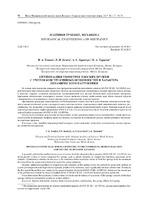| dc.contributor.author | Томило, В. А. | ru |
| dc.contributor.author | Кочик, Е. В. | ru |
| dc.contributor.author | Кравчук, А. С. | ru |
| dc.contributor.author | Тарасюк, И. А. | ru |
| dc.date.accessioned | 2021-11-17T10:23:28Z | |
| dc.date.available | 2021-11-17T10:23:28Z | |
| dc.date.issued | 2017 | ru |
| dc.identifier.citation | Оптимизация геометрии плоских пружин с учетом конструктивных особенностей и характера динамического нагружения = Optimization of flat spring geometry with considering design features and nature of dynamic loading / В. А. Томило [и др.] // Весцi Нацыянальнай акадэмii навук Беларусi. – 2017. – № 1. – С. 70-75. | ru |
| dc.identifier.uri | https://rep.bntu.by/handle/data/106823 | en |
| dc.description.abstract | На основе использования макросов для программы конечноэлементного анализа ANSYS 10 ED / LS-DYNA разработана методика оптимизации геометрии системы последовательно соединенных плоских пружин, используемых в качестве упругих элементов катапульты, предназначенной для запуска беспилотных летательных аппаратов. Критерием оптимизации геометрии в данном случае является условие наибольшего хода обеих плоских пружин с наименьшим отклонением от симметричных форм относительно середин пружин. Произведена редукция динамической оптимизационной задачи сжатия и расслабления системы плоских пружин к квазистатической задаче предварительного сжатия системы и высокоскоростной динамической задачи ее расслабления, что позволило существенно сократить время решения оптимизационной задачи. Решение первой части задачи производилось Implicit-решателем ANSYS 10 ED, и по его результатам было получено решение второй части задачи Explicit-решателем ANSYS 10 ED / LS-DYNA. Исходя из полученных результатов, оптимальной с точки зрения величин хода и отклонений от симметрии плоских пружин переменного профиля является система, состоящая из одинаковых рессор, симметричных относительно середины профиля. | ru |
| dc.language.iso | ru | ru |
| dc.title | Оптимизация геометрии плоских пружин с учетом конструктивных особенностей и характера динамического нагружения | ru |
| dc.title.alternative | Optimization of flat spring geometry with considering design features and nature of dynamic loading | en |
| dc.type | Article | en |
| local.description.annotation | A geometry optimization method based on use of macros for finite-element analysis program ANSYS 10 ED / LS-DYNA was developed for system of series-connected flat springs used as elastic elements of catapult for launching unmanned aerial vehicles. Optimization criterion in this case is the condition of the maximum stroke of both flat springs with the minimum deviation from the symmetrical form with respect to spring midpoints. Dynamic optimization problem of compression and relaxation of flat spring system was reduced to quasi-static problem of system pre-compression and high-velocity dynamic problem of its relaxation, and it significantly reduced solution time. Solution to the first part of the problem was carried out by means of Implicit Solver of ANSYS 10 ED / LS-DYNA. Solution to the second part of the problem was obtained by means of Explicit Solver of ANSYS 10 ED / LS-DYNA based on previous part results. It was determined that optimum system in terms of stroke and deviations of symmetry of flat springs consists of identical springs which are symmetrical relative to section middles. | en |

